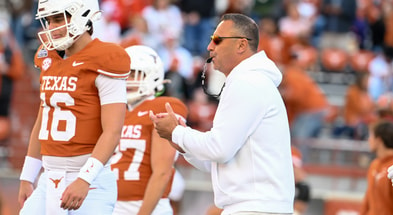Column: The College Football Playoff committee must get this process right, unlike the AP poll

The AP Poll has been a mess all season. The College Football Playoff must strive to be better in its rankings.
[Join Inside Texas TODAY with code HOOKEM and get 50% off annual memberships!]
The mediocrity of the AP Poll has not been some under lock-and-key, well-kept secret within the media. Many fans are tired of how the AP Poll is done, with pre-season expectations and team/conference bias playing heavily into the rankings. You can even look at this week. A 6-2 Clemson team, fresh off a terrible loss to Louisville and with its best win over NC State, is ranked ahead 7-1 Washington State. The Cougars, floating along in the Pac-12, lost to Boise State but has wins over Texas Tech and Washington.
Thankfully for the sanity of the college football world, the AP Poll has little bearing at this point in the CFB cycle. It doesn’t dictate College Football Playoff results and is nothing more than a glorified popularity contest that runs year-round once the CFP releases its rankings.
With the first CFP poll, an actual poll that matters debuting later this evening, it’s important that the work of the committee is done correctly.
The CFP poll is what determines who makes the Playoff, and with only seven at-large bids up for grabs in the 12-team field, getting things correct is imperative. This is how the committee defines its criteria:
“The selection committee ranks the teams based on the members’ evaluation of the teams’ performance on the field, using conference championships won, strength of schedule, head-to-head results, and comparison of results against common opponents to decide among teams that are comparable.”
This is where the idea of ratings versus rankings becomes imperative. A team inherently has a ranking and a rating in a sport like this. The rating is how good a team is on any given Saturday. Teams like Texas and Georgia are at the top, while teams like Florida can be rated highly despite four losses. On the flipside, rankings are resume-based hierarchies that embodies how well a team has performed on the field during the year.
Does that wording sound familiar?
What must happen tonight, and for the rest of the season, is for the committee to rank off of resume correctly, something the AP poll has failed to do. The AP feels like a mix of rating and ranking without any rhyme or reason, lacking a flow on what makes one team allowed to be ranked off rating rather than resume. That’s inherent in its nature as an amalgamation of votes from 62 different media members (and a good indication as to why the BCS using the human-based Harris Poll with 105 different voters was not the system college football needed).
However, rating is still very important for this process. What the committee has done in the past is use metrics like “Top 25 Wins,” “Wins over .500 teams” and other ranking-based metrics.
Stop. Doing. That.
The Kelley Ford Ratings, a website and Twitter page run by a college football analyst and ratings evaluator, allow us to take a glimpse into how highly-rated a team is. As seen below, a team like South Carolina isn’t in the AP top 25 but is rated as a top 15 team. That’s because they’ve lost to LSU and Alabama in close games, with the only real blemish on their resume being a non-competitive loss to Ole Miss.
During the last two weeks, the Gamecocks have gone to OU and hosted Texas A&M and won both games comfortably. When teams play and beat South Carolina, they should be given a top 15 rated win, even with Shane Beamer’s program not being ranked.

So, what do we do about this? Well, the goal of this article is to rank where each SEC team should land in this first playoff poll amongst themselves. This isn’t going to compare Miami to A&M or Indiana to Ole Miss, it’s strictly going to cover how well each SEC has done this year. The criteria are shown below:

These cutoffs may seem arbitrary, but it’s just the opposite. Is there any actual reason, apart from it being a pretty number, that the AP poll is a top 25? Instead of using round numbers, we’ll use tier breaks. The difference between No. 9 Miami and No. 10 Penn State is the difference between No. 13 Clemson and No. 17 SMU. They should be weighed in that way. Every game is categorized into 10 distinct categories, from Elite win to egregious loss. Knock off a top nine rated team, no matter the field? You get an elite win. Lose to West Virginia at home while trying to make the playoffs? Egregious loss.
With that out of the way, here is a resume-based look at the SEC teams competing for the playoffs still.

As you can see, many SEC teams have multiple null games, or matchups where a win doesn’t help their resume.
If this is too hard to digest, here it is without the fluff, with each team descending from best win to worst loss:

There is an obvious tier break after Alabama here. Vandy has a great win against the Crimson Tide, but the Commodores possess the worst loss of all SEC teams at Georgia State. Missouri is the only team that has yet to earn a signature win. Of course, South Carolina has three losses.
Top 10
- 1New
Predicting AP Top 25
Top 10 shakeup coming
- 2
Duce Robinson commits
FSU lands highly-rated transfer WR
- 3Hot
Kirk Herbstreit
Shot fired at First Take, Stephen A. Smith
- 4
Ohio State vs. Oregon odds
Early Rose Bowl line released
- 5
Updated CFP Bracket
Quarterfinal matchups set
Get the On3 Top 10 to your inbox every morning
By clicking "Subscribe to Newsletter", I agree to On3's Privacy Notice, Terms, and use of my personal information described therein.
So how does one read and interpret this, and what should the rankings look like?
If the CFP committee truly wants to make a resume-based ranking system, then the goal here is to be as objective as possible, even if it likely doesn’t go in Texas’ favor. Texas has only played four games of note this year, losing the only one that could’ve been seen as a true ‘signature win.’ It’s not the Longhorn’s fault in scheduling — Oklahoma and Michigan should be better — but until the A&M game Texas should expect to live a little lower than expected.
Tier 1: Georgia
Georgia has the second-best resume in college football. They beat an elite rated Texas team, and the only loss was close and to another elite team. Convincing wins against Clemson and Florida also help. They should be the No. 2 team behind Oregon.
Tier 2: Tennessee
Tennessee is pretty simple. The loss to Arkansas means they can’t be a top five team, but by all means this resume is one belonging to a CFP team. The Vols have an elite win over Alabama and handling OU in Norman at night is commendable. This should be a top eight team in these rankings.
Tier 3: Texas, A&M, Texas, LSU, Alabama
These four should all be on the cusp or inside the top 12, but I’m not sure you can say their resumes are better than some of the Big 10 or other power conference schools. This is where Longhorn fans could see Texas tumble. Only four important matchups is a hard sell to voters so far.
Long story short? Texas simply just needs to win out in four matchups where they are favored to become a playoff team.
In general, all four of these teams must win out.
Good thing here is Texas plays at Texas A&M on November 30, and LSU hosts Alabama this weekend. This’ll be sorted out.
Texas hasn’t really played anyone, A&M doesn’t have an elite win like LSU or Bama, but those two teams have some rough losses. The season-opening loss to USC has not aged well for the Tigers.
Tier 4: Ole Miss, South Carolina
A bit of a wildcard in this tier. Neither of these teams have the resumes to be in the top 12, maybe even the top 20, but are both very well-rated teams. Ole Miss is obviously good, the Rebels destroyed South Carolina and Arkansas, but losing to Kentucky has hurt them greatly. South Carolina has three losses, but they are arguably quality L’s. Both of these teams have to win out and then have other things happen around the country but it’s not outside the realm of possibility, at least not until we know what the committee really thinks.
Tier 5: Missouri, Vanderbilt, Florida, Oklahoma
Vanderbilt has bad losses, Missouri hasn’t beaten anyone, and Florida and Oklahoma probably won’t be in this discussion in two weeks.
[Subscribe to the Inside Texas YouTube channel!]
Overall, this is not a perfect expression of what the Playoffs are, that’s not fully the point. One would need to gloss over and weigh multiple rating systems, mostly behind paywalls, and that’s not easy to do in such a short span of time.
What should be taken away from this exercise is how poorly the AP Poll often gets rankings. Tennessee should surely be ahead of Texas (and probably Penn State) and Ole Miss being right behind Texas A&M is a poor ranking. These aren’t IT’s predictions for who will make it, but rather where the committee should have the teams ranked in this first poll. The committee has a lot of pressure on them this season with the dawn of the 12-team playoff, and it needs to be done correctly.
Evan Vieth is a junior journalism major and the sports editor for The Daily Texan.

























